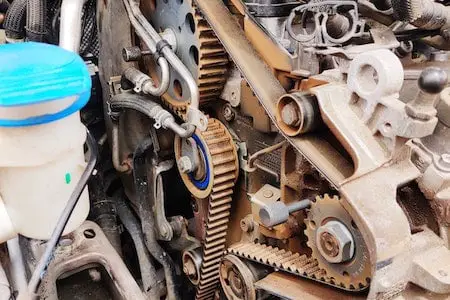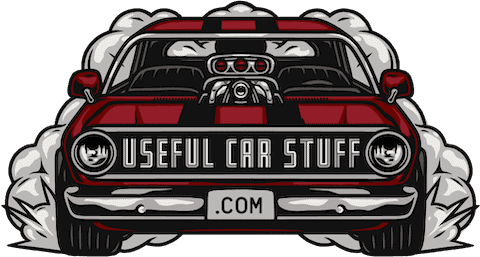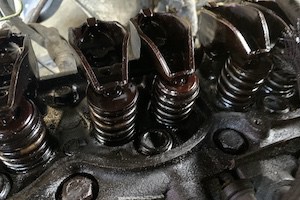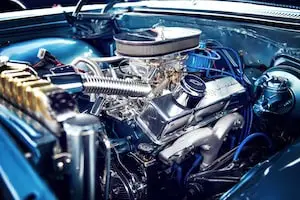Ever taken your car into the shop for a small oil leak and the mechanic comes back at you with a 3,000 dollar repair quote? Happened to me just this past year.
A family member took her car into the mechanic shop to check on a slight oil leak leaving spots on the driveway. It was traced back to be a leak at the water pump gasket. With 70,000 miles on the engine, the mechanic also recommended the timing belt and the water pump be replaced. Might as well throw in an engine mount, and change some filters, so a grand total of three thousand dollars!
Wait a minute, the timing belt only has 70,000 miles on it. Does it really need to be changed?
I suppose the oil leak would be a good thing to resolve but why don’t I just fix the leak and put the old parts back on the car. They’ll probably be good for another 30,000 miles anyways.

Do I really need to replace my timing belt?
If the timing belt is more than 10 years old or has more that 50,000 miles the timing belt should definitely be replaced if other work is being done to the engine anyways. If the water pump or other gasket is being replaced at the same time the timing belt should be replaced to eliminate the risk of a failed timing belt.
The timing belt breaks down and will eventually fail and by taking action and replacing the belt before it completely wears out you eliminate the risk of a failed timing belt and the catastrophic damage that can cause.
There are a few instances and signs to look out for that will indicate that a timing belt replacement is more urgent than others and I will cover those things further in the post.
The Timing Belt Must Be Replaced
Don’t talk yourself out of this one. If you are considering a timing belt replacement then the best idea is to error on the side of replace it before it breaks. It simply needs to be done!
The idea here is that it is replaced before the point that the car announces to you that it has broken!
The timing belt plays a critical role in the operation of the engine and is not something that should be ignored or delayed like a small leak from a gasket or rubber bushings that are beginning to squeak.
The timing belt keeps the engine “in time”. It ensures that the cylinders and the valves are moving at exactly the same time keeping in sync. The timing belt is the connection between the crankshaft and the camshaft. The first moving with the pistons and the later moving with the valves.
In general it is recommended to replace the timing belt between 60-100,000 miles on the car. I have seen belts last longer and typically they are changed at 80,000 miles.
Preventative Maintenance
Preventative maintenance is initiating a replacement of parts that are still working but are worn out and they are replaced before they fail completely.
Some of the main items that should be treated with preventative maintenance are: rubber hoses, brake pads, tires, suspension components, aannnd.. the timing belt!
Timing belt replacement must be done as “preventative maintenance”.
I have experience both replacing parts while they are “still good” and replacing them when they are “not good” on the side of the road or in a random parking lot and it is much more pleasant to replace the parts when and where you decide.
The parts cost the same now as they will in a few more miles when the part you are considering changing has failed. Might as well replace it now!
Damage can Occur From a Broken Timing Belt
A failed timing belt will cause the car to be thrown out of timing. More severe damage will be caused if the Pistons and valves collide which as possible when the timing belt is broken.
Postponing replacement of the timing belt is simply not worth the risk of this serious damage that can occur. A little further in this post I will explain more what kind of serious damage is caused by a failed timing belt.
When The Timing Belt Should Be Replaced
The timing belt should be replaced typically between 60,000 – 100,000 miles or if it is more that 10 years old. Miles put wear on the belt and time alone allows the material to break down and weaken.
Any concern or consideration to replacing the belt should lead to action to simply have it replaced while the car is running before it decides one day to break.
If the car is equipped with a chain, typically the timing chain will last longer and can be used for more miles and more years. A belt is more prone to breaking because it is made of rubber. And other components mixed in of course.
Timing belt should be replaced typically between
60,000 – 100,000 miles
Replace Timing Belt with Other Things at the Same Time
If you are diving into some other maintenance for the car, perhaps a serpentine belt replacement, or a water pump replacement, or engine mount, or a leaking gasket fix, it is generally a good idea to replace the timing belt because it can be difficult to access.
If you are in the area of the engine having work done anyways, it becomes easier to simply change the timing belt and might as well replace it before it breaks!
The water pump for example on many cars is on the outside of the engine and can be replaced without removing other components, but on some it is behind the timing belt. For this repair, when replacing the timing belt, it becomes a job that requires no extra labor to replace the belt at the same time.
When getting a quote from a repair shop, this is something to pay attention to and ensure that the shop is not charging much extra labor when a replacement of the timing belt is done along with the water pump and one must be removed to replace the other. It simply will take little extra effort to add the replacement of another component in the same place.
2 Instances a Timing Belt Replacement Becomes URGENT
1. Cracks
It is possible to see the timing belt without removing covers but generally is well covered by plastic. These covers can be easily removed to inspect the timing belt, and a timing belt inspection should be done once a year.
It cracks or a tear or other wear is noticed then it should be replaced as soon as possible.
If the timing belt does not look brand new, replace it.
2. Leaking Water Pump
A leak from the water pump can cause damage and premature wear to the timing belt.
If the leak has been a long term issue, then the coolant has gotten onto the timing belt and has by constantly having coolant drip on the belt will wear it out very quickly. Antifreeze can cause the rubber composite of the timing belt to wear out and the timing belt should be replaced if it had coolant on it for more than a week or so.
Damage Caused if I Don’t Replace the Timing Belt
If you do not replace the timing belt, eventually damage WILL occur to the engine. Damage occurs from an old timing belt when the belt eventually breaks or is worn enough for the belt to slip. A slip of the belt causes timing of the pistons an valves to be off and a broken belt will stop the engine from running completely.
Timing belts naturally break down over time. They dry out and the material gradually deteriorates. Miles on the car with the constant pull on the timing belt will also gradually wear out the belt.
As the belt wears, it will stretch and the belt tensioner is a pulley that keeps constant pressure on the belt so even if it stretches it will remain taught.
Once the belt deteriorates enough it can slip and become out of alignment. This will cause the engine to run very poorly with the timing off and the belt must be replaced and the timing reset to fix it.
Interference Engine Damage
A broken timing belt will cause serious damage to the engine if the engine is an “interference engine” which is when the valves and cylinders have the potential of making contact if the timing is off far enough.
Most engines are “non-interference” and so no matter how high up the piston is and how low the cylinder is, they cannot make contact.
If the engine is “non-interference” then the only damage that will be done is typically misfires and the engine will quit and will have to be re-timed.
When an interference engine has a timing belt break, the pistons and valves can collide and will cause enough damage for some of the valves to be bent or broken and can crack or break the pistons.
To assess the damage caused from a broken timing belt on an interference engine, the head must be removed and the pistons and valves inspected.
Related Questions
Does a timing chain or timing belt last longer?
Timing chains last longer than timing belts because they are made of a stronger material. The stainless steel that is used for a timing chain breaks down much slower than that of a timing belt. Typically with a chain it is not the chain that wears out first, rather it is the sprocket teeth.
What does a bad timing belt sound like?
A bad timing belt is one that is about to fail and can be squeaky from being dry and cracked but typically bad timing belts break with no warning.
Does a timing belt make noise when it is worn out?
A timing belt can cause a ticking or squeaking noise when it is worn out but will most often break without warning or producing noise.
Will a car start with a broken timing belt?
An engine is unable to run with a broken timing belt. The timing belt must be connected for the engine to run or turn over properly.


